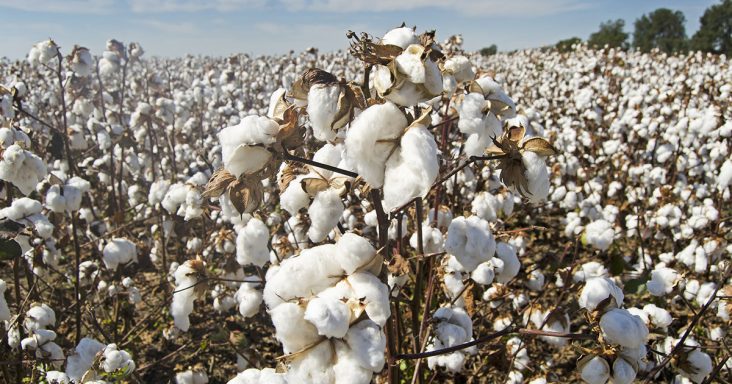USDA projects Arkansas crop acres to increase in 2023
by April 10, 2023 9:34 am 903 views

Arkansas’ planted row crop acres are predicted to jump by 52,000 acres this year, according to the U.S. Department of Agriculture. USDA’s annual Prospective Plantings report forecasts growers intend to plant more than 7 million acres of soybean, rice, cotton and other major crops this year.
Nationally, America’s farmers intend to plant more than 318 million acres.
The acreage isn’t going fallow, however. Hunter Biram, extension economist for the Division of Agriculture, said growers will simply shift those acres to more profitable crops.
The report, based on survey data gathered by USDA’s National Agricultural Statistics Service, noted that the drought conditions impacted agriculture throughout the country for much of 2022 began to lessen in the fall and winter months. The country experienced a record-setting streak with at least 40% drought coverage of 126 weeks, finally ending in February of this year, the report stated.
Pasture area was particularly affected by the drought. Although most input prices remain high relative to pre-pandemic markets, many have fallen significantly from their 2022 peak.
“Key nutrient prices are down year-over-year,” Biram said. “According to Bloomberg Green Markets, urea is down 60%, DAP is down 33% and potash is down 45% compared to this time last year. Given this, I think expected harvest time crop prices are driving prospective plantings.”
The most notable shift in this year’s intentions is the fall in Arkansas cotton acres, which fell 25% to 480,000 acres. Vic Ford, associate vice president for agriculture and natural resources for the University of Arkansas System Division of Agriculture, said a combination of high input costs and low market prices likely made the choice a necessary one for many producers.
“High input costs, such as seeds, fertilizer, chemicals, fuel and equipment combined with low crop prices have made cotton less profitable,” Ford said. “Other crops are being favored because of this.”
Cotton acres fell steeply across the entire country as well, with overall acreage falling 18% to less than 11.3 million acres.
Arkansas growers expanded wheat acreage by about 5% from 220,000 in 2022 to 230,000 acres. Nationally, winter wheat acres grew by 13%.
Jason Kelley, extension wheat and feed grains agronomist for the Division of Agriculture, said that cost-benefit analysis played a strong hand in the shift of acreage toward wheat.
“Winter wheat seedings increased slightly during the fall of 2022, partially due to the reduction in fertilizer costs and attractive grain prices,” Kelley said. “The dry fall was helpful for farmers to get their summer crops harvested ahead of wheat planting, but wet weather in late October and November limited wheat acres in some areas of the state.”
Arkansas hay production appears likely to increase marginally, rising 3% to more than 1.1 million acres. Nationally, hay acreage looks to expand by about 2% to more than 50.6 million acres.
The state’s corn growers appear optimistic about the crop’s future, increasing acreage 14% to 810,000 acres. By comparison, the prediction for all U.S. corn acreage increased by only 4%.
“We expected corn acres to be up in 2023 compared to last year’s 750,000 acres. The drop in fertilizer prices along with still relatively high grain prices helped increase interest in corn planting intentions in Arkansas and across the U.S. as well. Last year, corn acres were down in some areas of the state due to wet conditions in April that prevented planting, so this year’s increase is also a reflection of producers trying to get back to their normal crop rotation.”
Rice acreage is projected to grow by 18% when compared to 2022, to more than 1.3 million acres. Nationally, growers expect to expand their acreage by 16% to nearly 2.6 million acres.
Jarrod Hardke, extension rice agronomist for the Division of Agriculture, said the 2023 numbers were unsurprising.
“Prospective plantings report intentions were right in line with expectations at this point,” Hardke said. “We’ve been predicting about 1.3 million acres of rice total. The question mark has been more around the breakdown of long grain versus medium grain.”
“Two straight lower acreage years for rice in Arkansas — 2021-2022 — have had growers geared up for more rice acres in 2023,” he said. “There was better land preparation last fall than we have seen in some time; however, the winter turned and remained wet once again so there’s still a lot of ground waiting to be prepared for planting.”
Arkansas soybean growers appear to be planting slightly fewer acres of the crop in 2023, with intended acreage falling 4% to just over 3 million acres. Nationally, acreage for the crop remains steady from 2022 at 87.5 million acres.
Jeremy Ross, extension soybean agronomist for the Division of Agriculture, said that final acreage for the state’s largest crop is largely weather-dependent.
“The final numbers are going to be dictated by the weather over the next three months,” Ross said. “If we stay in this pattern that we’ve been in, we may see more soybean acres.”
Arkansas remains a small-but-mighty peanut-producing state, with intended acres growing 6% to 35,000 acres. Nationally, intended peanut acres grew 7% to more than 1.5 million acres.
Travis Faske, extension plant pathologist and acting peanut agronomist for the Division of Agriculture, said the modest increase in peanut acres was another factor related to the significant drop in cotton acreage.
